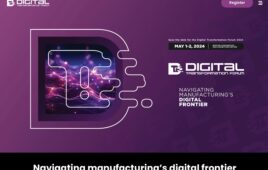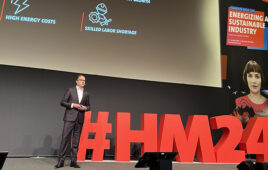By Keith Higgins, VP of Digital Transformation, Rockwell Automation
To help identify design issues earlier in the machine build cycle, machine designers look to virtually commission new production lines using digital twin technology. This technology can simulate nearly every aspect of machine operation without needing access to a single piece of physical equipment. It allows customers to optimize their manufacturing design in a virtual environment prior to investing in the physical world.
Although the virtual commissioning concept has been around for a few years – many organizations are still figuring out how to get the most out of their virtual production processes. For example, understanding how and why to connect the digital twin to the real operational logic of its control system.
What is virtual commissioning?
As consumers demand new products and more variety, companies race against the clock to stay ahead and deliver. One tried and true solution is to find new motors, hydraulics and other components that can withstand more demanding requirements to improve machine performance, which are integrated into existing machines with minimal disruption.
However, controls testing on a new or updated machine occurs at the very end of the project when the start-up deadline is approaching. A variety of issues can still occur at this stage, for example a functionality problem such as an unexpected stoppage or a misplaced sensor, or a last-minute customer concern, like the HMI’s sequence or layout. Industrial companies report that fixing a machine issue during commissioning can be 100x more costly than fixing it in the design phase.
These are the reasons behind the move to virtual commissioning, a process that uses a digital model and simulation of a machine to perform controls testing before the machine is built. The goal is to identify design issues as early in the build cycle as possible.
Once tests on a virtual machine are completed, it often takes less than two days of machine downtime to implement optimizations to existing machine operation. Virtual commissioning enables the creation of a virtual environment that uses real operational logic and connects to a control system. Designers and engineers can test, debug, and verify performance before customers bolt the machine into the floor of their plant.
Virtual commissioning is enabled by software that creates a digital twin of a machine design. An effective digital twin is not just a 3D visual model. Physics can be applied to test operation and interactions with people or other machines. An interactive digital twin of both the machine design and the real operational logic of the control system can verify and demonstrate the operation of the machine and the controller before it goes into production.
Creating a digital twin of a machine using simulation software involves three primary steps: first, bring in the machine’s CAD. Then, mockup the machine’s movements and devices like sensors on the CAD. Finally, connect the CAD to the controller and its tags. And with that, designers have an open sandbox where they can test a machine and its logic digitally. This helps organizations take control testing off the critical path and avoid making changes at the 11th hour.
How to optimize virtual environments
The value of digital engineering doesn’t stop after machines are commissioned. There are many different use cases where these virtual environments can improve how workers do their jobs and make decisions. Once production starts, digital twins can mimic processes, machines and controls to help plant personnel learn about operations and experiment with changes. Operators can make mistakes without consequence. And, they can be trained in normal scenarios as well as exceptional ones.
They can also be required to demonstrate procedures, awareness and effectiveness before they start working in a real production environment. Virtual training also reduces costs, since trainees do not have to travel to a training location or rely on equipment being available. Instead, they can access everything digitally.
A digital twin can change how organizations see, run and manage production. For example, manufacturers can use real-time 3D simulations to do a trial run on how to run products, machines and facilities at maximum throughput. Running a digital twin in parallel with a real machine also helps organizations identify issues as the machine’s performance drifts from the model.
Additionally, technicians can use a digital twin to reduce downtime or even get ahead of it. Technicians can use a digital twin of a machine within an augmented reality (AR) environment to troubleshoot issues before shutting it down. They can use the AR technology to digitally overlay work instructions on the physical machine to expedite repair. Creating predictive models with a digital twin also helps technicians get ahead of failures. Then, the required maintenance can be scheduled during a planned shutdown.
Gartner estimates that businesses will save US$1 trillion each year in asset maintenance by using IoT through digital twins. What’s more, 30% of Global 2000 companies will be using data from digital twins of IoT connected products and assets to improve product innovation success rates and organizational productivity, achieving gains of up to 25%.
In junction with digital twins, a digital thread is a strategic framework that aims to optimize the product, asset, system, or process lifecycle by interconnecting critical functions across an organization. This includes the digital trail of data created by a digital twin across an asset’s lifecycle. Connecting ERP, EMS, MES, and MOM systems via a digital thread allows information to flow between systems to inform and optimize business-driving processes from design, to supply chain, to production. A digital thread-powered strategy provides the entire value chain with access to unified digital data captured during design, virtual simulation, and physical operations. By harnessing the digital thread, organizations can enable coherent data flow throughout the organization, from design to maintenance, which leads to improvements and benefits throughout the entire operation.
Rockwell Automation
www.rockwellautomation.com
Filed Under: IoT • IIoT • Internet of things • Industry 4.0, DIGITAL TRANSFORMATION (DX)




